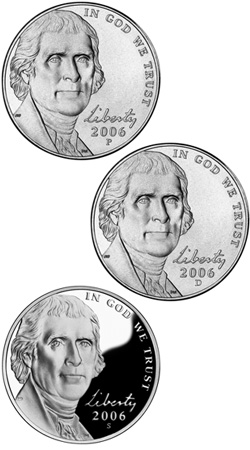Why Mint Marks?
The use of mint marks dates from the days of ancient Greece and Rome. A Congressional Act of March 3, 1835, established the practice in the United States, along with the first Mint branches in this country. Through this Act, the Director of the Mint set mint marks to identify the coins stamped at each facility so as to standardize production and establish responsibility for the coinage.
Currently, all circulating coinage produced at the Philadelphia Mint has a "P" mint mark except for the one-cent coin, or penny, which has none.
Because of its secondary importance in any coin’s design, the mint mark is customarily made as inconspicuous as possible without losing its function.
Philadelphia Mint Marks
Philadelphia was the only branch in operation in the earliest years, so identifying the coinage source was not necessary. The practice of not identifying Philadelphia’s coins was continued even after the first branches were established.

In 1942, however, when World War II necessitated removing nickel from the 5-cent coin’s alloy, the mint mark was moved from the right of Monticello to above the dome to indicate the substitute alloy. At the same time, the letter "P" first appeared on Philadelphia coinage.
After the war, when use of the regular alloy was resumed, the mint mark was restored to its former position and Philadelphia's "P" was no longer used.
In July of 1979, the Susan B. Anthony dollar coin was introduced, replacing the larger dollar coin. Once again, the "P" mint mark appeared, this time on the dollar denomination.
Denver Mint Marks
Denver coins have always carried the letter "D" except during the date freeze mentioned later in this text. (See: The Coinage Act of 1965.)
San Francisco and West Point Mint Marks
Use of the "S" and "W" mint marks has been sporadic because of changing conditions. The "S" Mint mark was used on San Francisco coins until 1975, although production in San Francisco was suspended between 1955 and 1965. San Francisco made cents for circulation from 1968 through 1974, nickels from 1968 through 1970, and dimes in 1975.
Circulating cents were manufactured in the early 1980s at San Francisco and the West Point Bullion Depository, but no mint marks were used, assuring maximum circulation of this small production.
Special Mint sets were produced for collectors at San Francisco from 1965 through 1967, but no mint marks were used because of then-current restrictions.
In 1968, proof coin production was moved from Philadelphia to San Francisco, where the proof coins gained the "S" mark. Proofs subsequently made at West Point carry the "W" mint mark.
The Coinage Act of 1965
The coinage Act of 1965 prohibited mint marks for five years. This, together with the date freeze, eliminated distinguishing features that could tempt people to remove the coins from circulation while the Mint was striving to meet the country’s need for coins. No mint marks appear on coins dated 1965, 1966, and 1967.
Congress authorized resumption of the practice in 1968, at which time the mint marks, usually on the back of the coins before 1968, were permanently relocated to the front.
All master dies, including those used in the Mint's numismatics and medals programs, are manufactured in the Die Manufacturing Division of the Philadelphia Mint. Mint marks are added to the hubs at Philadelphia. These hubs make the working dies used to stamp coins. Mint-marked working dies are then delivered to the appropriate Mint facility for use in coining.
All the working dies needed for the Denver facility are produced by the Denver Die Manufacturing Division along with some of the dies for the San Francisco facility.
